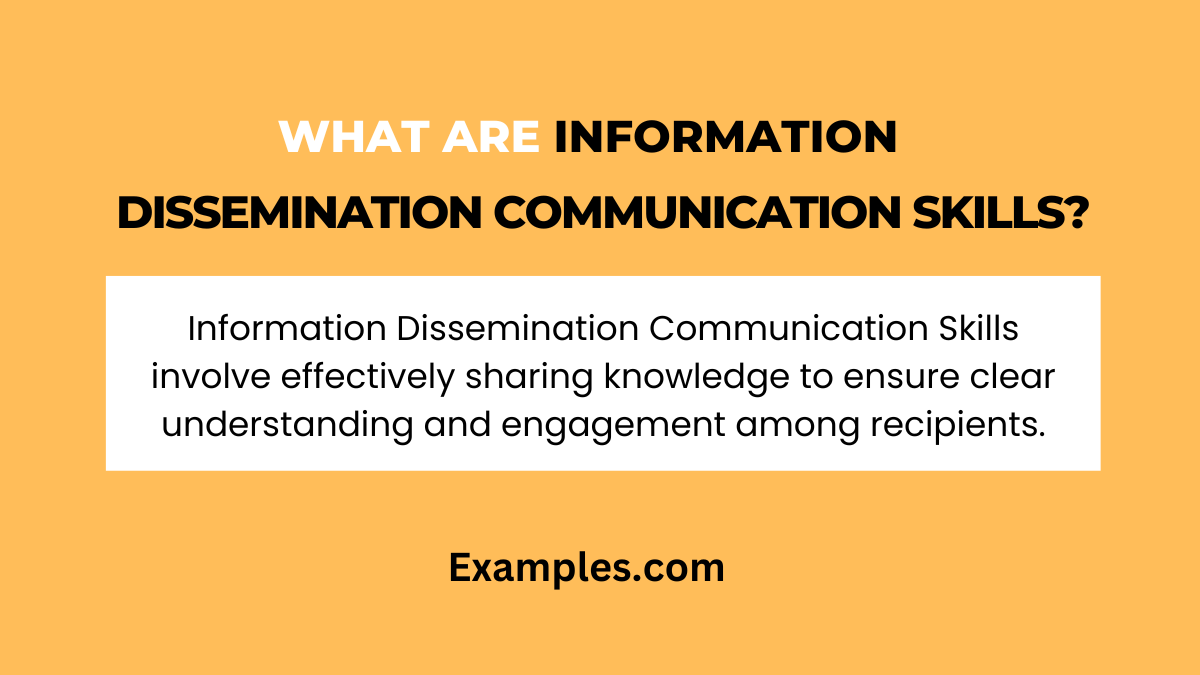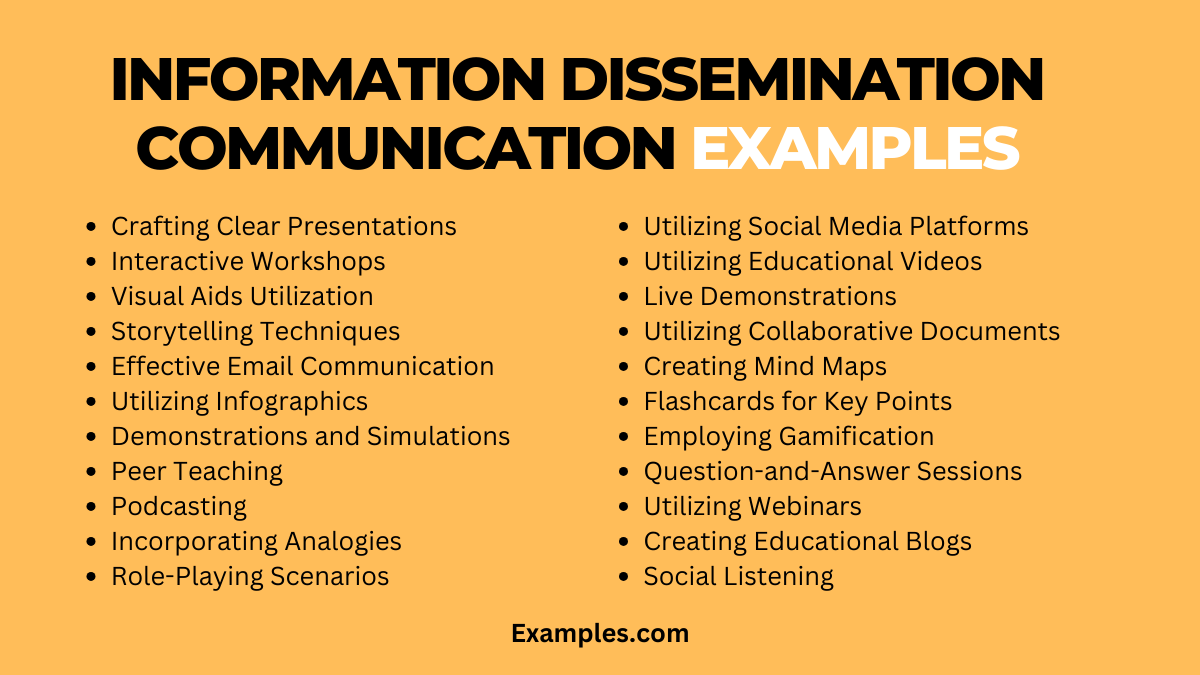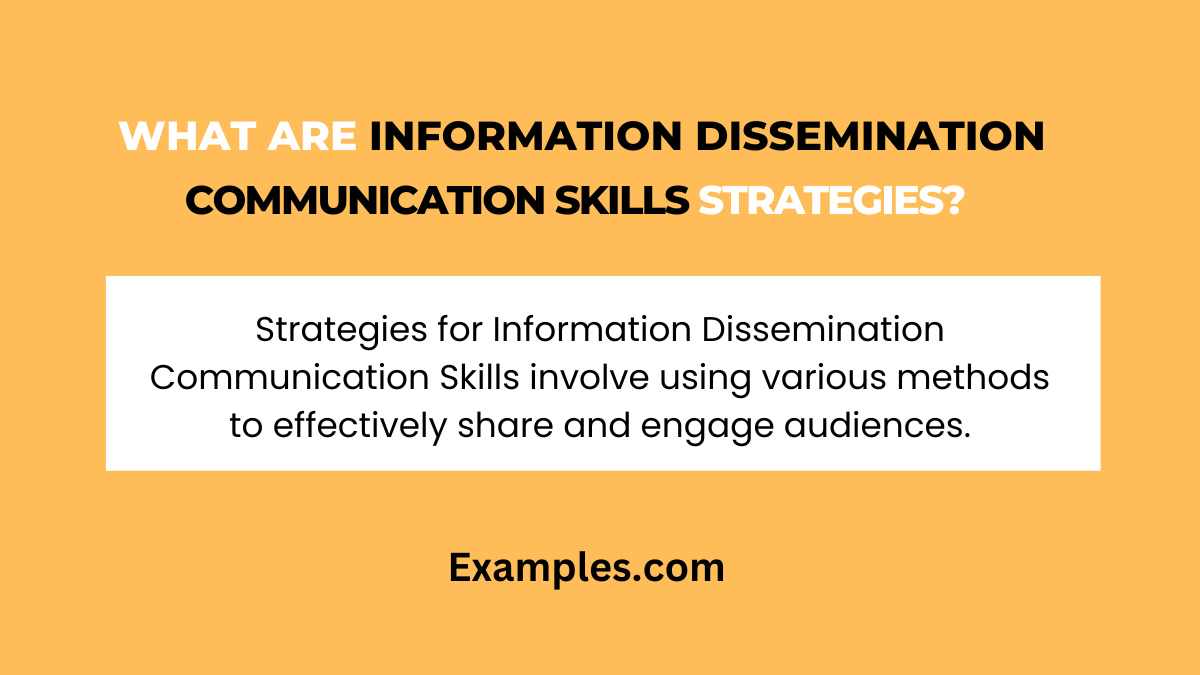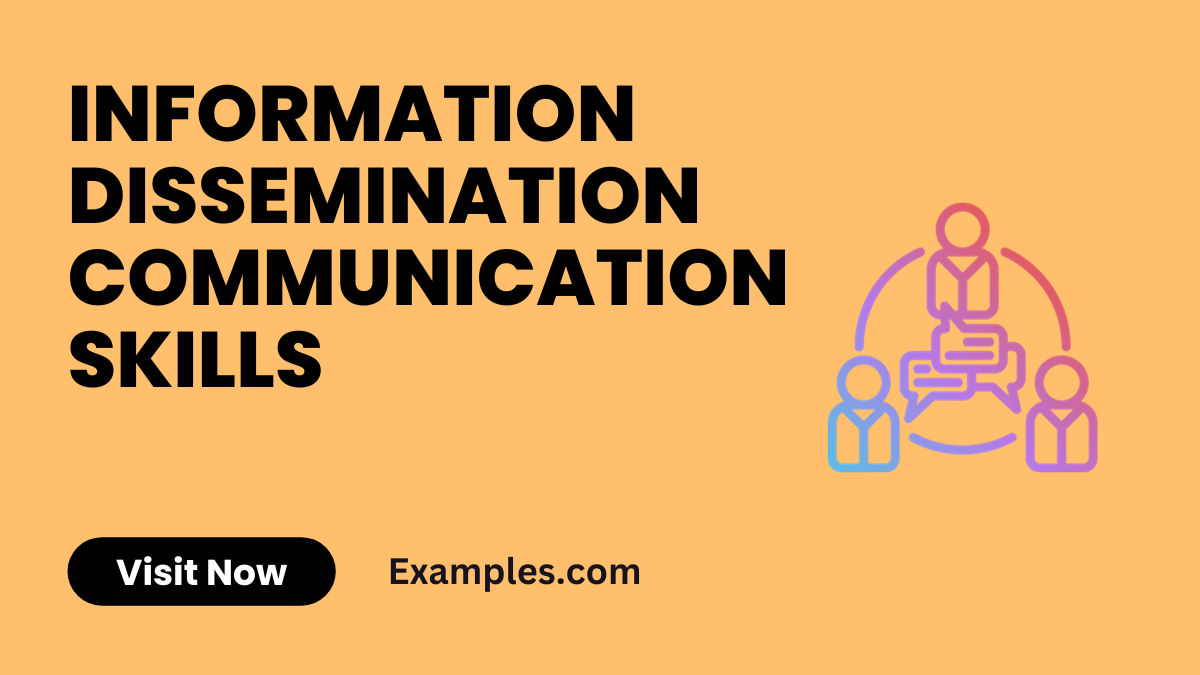Information Dissemination Communication Skills
Unlock the essence of Information Dissemination Communication Skills, a vital facet of effective communication. These skills involve conveying information clearly, ensuring understanding and engagement across various domains. From education to healthcare and business, mastering these skills is essential for impactful communication.
What are Information Dissemination Communication Skills?

Information Dissemination Communication Skills encompass the ability to effectively share knowledge with a target audience. It involves presenting information clearly, employing diverse communication channels, and adapting content for better comprehension. These skills are pivotal in disseminating information in educational, professional, and interpersonal settings.
30 Information Dissemination Communication Skills Examples

Explore a diverse array of Information Dissemination Communication Skills examples that transcend various contexts. Elevate your ability to convey ideas effectively with these practical illustrations.
- Crafting Clear Presentations: Structuring and delivering presentations with clarity and coherence ensures optimal understanding by the audience.
- Interactive Workshops: Engaging participants through interactive sessions enhances knowledge retention and fosters a collaborative learning environment.
- Visual Aids Utilization: Incorporating visuals like charts and graphs effectively communicates complex data, simplifying comprehension for diverse audiences.
- Storytelling Techniques: Weaving narratives into communication captures attention, making information memorable and impactful.
- Effective Email Communication: Writing concise and clear emails ensures that the recipient comprehends the message promptly.
- Utilizing Infographics: Creating visually appealing infographics helps convey information quickly, making data more accessible and engaging.
- Demonstrations and Simulations: Practical demonstrations and simulations provide hands-on understanding, facilitating effective information dissemination.
- Peer Teaching: Encouraging students to explain concepts to peers enhances both the teacher’s and the students’ understanding of the material.
- Podcasting: Utilizing podcasts allows for the dissemination of information through spoken content, reaching a broader audience.
- Incorporating Analogies: Drawing parallels between complex ideas and familiar concepts aids in easier comprehension.
- Role-Playing Scenarios: Simulating real-life scenarios through role-playing enhances understanding and application of information.
- Utilizing Social Media Platforms: Leveraging platforms like Twitter or LinkedIn for information dissemination caters to diverse audience preferences.
- Utilizing Educational Videos: Creating educational videos provides a dynamic way to share information and engage viewers.
- Live Demonstrations: Performing live demonstrations of processes or techniques ensures a firsthand understanding of the subject matter.
- Utilizing Collaborative Documents: Platforms like Google Docs allow real-time collaboration and sharing of information among multiple users.
- Creating Mind Maps: Visualizing complex ideas through mind maps aids in organizing and presenting information coherently.
- Flashcards for Key Points: Using flashcards to highlight key points enhances retention and reinforces essential information.
- Employing Gamification: Integrating game elements into learning makes information dissemination entertaining and effective.
- Question-and-Answer Sessions: Encouraging audience participation through Q&A sessions promotes active engagement and understanding.
- Utilizing Webinars: Hosting webinars allows for real-time interaction and dissemination of information to a global audience.
- Creating Educational Blogs: Maintaining educational blogs helps share insights, research findings, and information with a wide online audience.
- Engaging in Panel Discussions: Participating in panel discussions provides varied perspectives on a topic, enriching the understanding of the audience.
- Utilizing Case Studies: Presenting real-world case studies adds practical relevance and depth to the information being conveyed.
- Collaborative Group Projects: Assigning group projects encourages collaboration and the sharing of diverse ideas and information.
- Utilizing Virtual Reality (VR): Incorporating VR experiences provides immersive learning opportunities for complex subjects.
- Infusing Humor: Adding appropriate humor to presentations can make the information more memorable and engaging.
- Employing Analog Models: Using physical models or prototypes aids in conveying abstract concepts and enhancing understanding.
- Social Listening: Monitoring social media conversations helps in understanding audience interests and tailoring information accordingly.
- Creating How-To Guides: Developing step-by-step guides simplifies complex processes, aiding in effective information dissemination.
- Collaborative Knowledge Platforms: Utilizing platforms like Wikipedia or collaborative databases allows for collective knowledge sharing and dissemination.
Information Dissemination Communication Skills Examples for Students
Students can enhance their information dissemination communication skills by mastering techniques such as collaborative note-sharing, active participation in group projects, engaging in insightful class discussions, leveraging multimedia presentations, and utilizing online forums for academic collaboration.
- Online Study Groups: Students can use virtual study groups to share relevant resources and exchange insights, fostering collaborative learning.
- Classroom Presentations: Delivering well-organized presentations in class enhances the ability to disseminate information effectively to peers.
- Blogging about Subjects: Creating educational blogs allows students to share research findings, insights, and perspectives with a wider audience.
- Peer Tutoring: Assisting fellow students through peer tutoring promotes the dissemination of knowledge and supports a collaborative learning environment.
- Participation in Debates: Engaging in debates hones students’ skills in articulating and disseminating information persuasively and convincingly.
- Utilizing Educational Apps: Students can use educational apps to disseminate information in interactive and engaging formats, enhancing understanding.
- Contributing to Online Forums: Active participation in online forums allows students to share ideas, ask questions, and disseminate information within the academic community.
- Sharing Research Findings: Disseminating findings through poster presentations or research symposiums contributes to academic knowledge exchange.
- Creating Infographics: Crafting visually appealing infographics helps students present complex information concisely and comprehensively.
- Collaborative Group Projects: Working on collaborative projects enables students to disseminate information collectively, showcasing teamwork and effective communication.
Information Dissemination Communication Skills Examples for Resume
In the professional realm, effective information dissemination is crucial. Job seekers can highlight skills such as clear written communication, impactful presentations, report writing, social media management, and the ability to distill complex information into accessible formats.
- Strategic Report Writing: Writing comprehensive reports showcases the ability to disseminate complex information in a structured and clear manner.
- Social Media Campaign Management: Running successful social media campaigns demonstrates the skill of disseminating information to a wide audience effectively.
- Newsletter Creation: Crafting engaging newsletters for internal or external stakeholders showcases a talent for effective information dissemination.
- Executive Briefing: Preparing concise executive briefings demonstrates the ability to disseminate critical information to senior management.
- Client Presentations: Conducting impactful client presentations showcases the skill of disseminating information that aligns with client needs and expectations.
- Press Release Drafting: Writing press releases effectively communicates information to the media, public, and stakeholders.
- Creating Training Manuals: Developing training materials demonstrates the ability to disseminate procedural information clearly for employee development.
- Internal Memo Drafting: Crafting clear internal memos showcases effective information dissemination within the organizational context.
- Website Content Management: Managing website content involves disseminating information to online audiences in a user-friendly manner.
- Public Speaking Engagements: Participating in speaking engagements highlights the ability to disseminate information confidently and persuasively to diverse audiences.
Information Dissemination Communication Skills Examples in Healthcare
In healthcare, effective communication is paramount. Professionals can demonstrate information dissemination skills through patient education, health literacy initiatives, clear medical record documentation, collaborative case presentations, and conducting community health workshops.
- Patient Education Sessions: Conducting informative sessions for patients promotes health literacy and effective dissemination of medical information.
- Community Health Workshops: Leading workshops on health topics within the community contributes to public health education and information dissemination.
- Medical Blogging: Writing blogs on medical topics helps disseminate information to a broader audience, fostering health awareness.
- Clear Medical Record Documentation: Ensuring accurate and clear medical record entries supports effective information dissemination within healthcare teams.
- Telemedicine Consultations: Conducting virtual consultations involves effectively disseminating medical information to patients remotely.
- Interactive Health Apps: Developing or recommending interactive health apps encourages patients to engage in self-directed health information dissemination.
- Health Literacy Initiatives: Implementing programs to improve health literacy contributes to more effective patient communication and information dissemination.
- Collaborative Case Presentations: Sharing complex cases in interdisciplinary team meetings ensures comprehensive information dissemination for patient care.
- Participation in Medical Conferences: Presenting research findings or medical insights at conferences contributes to the dissemination of knowledge within the medical community.
- Health Podcasts: Creating podcasts on healthcare topics provides an accessible platform for disseminating information to a diverse audience.
What are Information Dissemination Communication Skills Strategies?

Effective information dissemination communication skills are crucial across various domains, including education, business, and healthcare. Employing strategic approaches enhances the impact of communication.
- Utilize Multiple Channels: Employ a variety of communication channels, such as written documents, verbal presentations, visual aids, and digital platforms. Tailor the medium to the audience and context for optimal information dissemination.
- Know Your Audience: Understand the needs, preferences, and knowledge level of your audience. This enables you to customize your communication to resonate with them effectively.
- Create Clear and Concise Messages: Craft messages that are clear, concise, and easily digestible. Avoid jargon and unnecessary complexity to ensure that information is disseminated with clarity.
- Leverage Technology: Embrace technological tools to facilitate information dissemination. Utilize collaborative platforms, social media, and multimedia presentations for dynamic communication.
- Encourage Two-Way Communication: Foster an environment that encourages feedback and questions. Two-way communication ensures that information is not only disseminated but also understood and retained.
How to Improve Information Dissemination Communication Skills?
Improving information dissemination communication skills requires intentional efforts and continuous development.
- Invest in Training Programs: Attend workshops or training sessions focused on communication skills. These programs often provide practical tips and exercises to enhance your ability to disseminate information effectively.
- Practice Active Listening: Sharpen your communication skills by actively listening to others. Understanding the nuances of effective listening contributes to clearer information dissemination.
- Seek Constructive Feedback: Request feedback on your communication style from peers or mentors. Constructive criticism helps identify areas for improvement.
- Stay Informed: Keep yourself informed about industry trends, relevant topics, and communication best practices. This knowledge enhances your ability to disseminate timely and pertinent information.
- Engage in Mock Scenarios: Practice information dissemination in simulated scenarios. This can include role-playing exercises or simulated presentations to refine your skills in a controlled environment.
Tips for Effective Information Dissemination Communication Skills
Maximize the impact of your information dissemination communication skills with these practical tips.
- Be Audience-Centric: Prioritize the needs and expectations of your audience when disseminating information. Tailor your communication style to align with their preferences.
- Use Visual Aids: Incorporate visuals like charts, graphs, or slides to complement your verbal communication. Visual aids enhance understanding and retention of information.
- Ensure Accessibility: Make information easily accessible to your audience. Organize content logically, use headings, and provide summaries for quick comprehension.
- Encourage Follow-Up: Promote follow-up discussions or provide additional resources for those seeking more information. This ensures a comprehensive understanding of the disseminated information.
- Stay Adaptable: Adapt your communication style to different situations and audiences. Flexibility ensures that information is disseminated effectively in diverse scenarios.
In conclusion, the mastery of Information Dissemination Communication Skills is a cornerstone for success in various domains, including education, business, healthcare, and more. These skills enable individuals to effectively share and explain information, ensuring it is received and understood as intended. To further enhance these skills, it’s beneficial to explore additional resources and methods.
One valuable resource is the Harvard Business Review (HBR), which offers insightful articles on effective communication strategies in professional settings. HBR’s extensive collection of materials can provide deeper understanding and practical tips for improving communication skills.
For those in the healthcare sector, the Centers for Disease Control and Prevention (CDC) offers a wealth of information on health communication and health literacy. Their guidelines and strategies are especially useful for professionals seeking to improve their ability to disseminate health-related information effectively.
By utilizing these resources, individuals can continue to develop their Information Dissemination Communication Skills, ensuring their messages are conveyed clearly, effectively, and in a manner that resonates with their intended audience.



